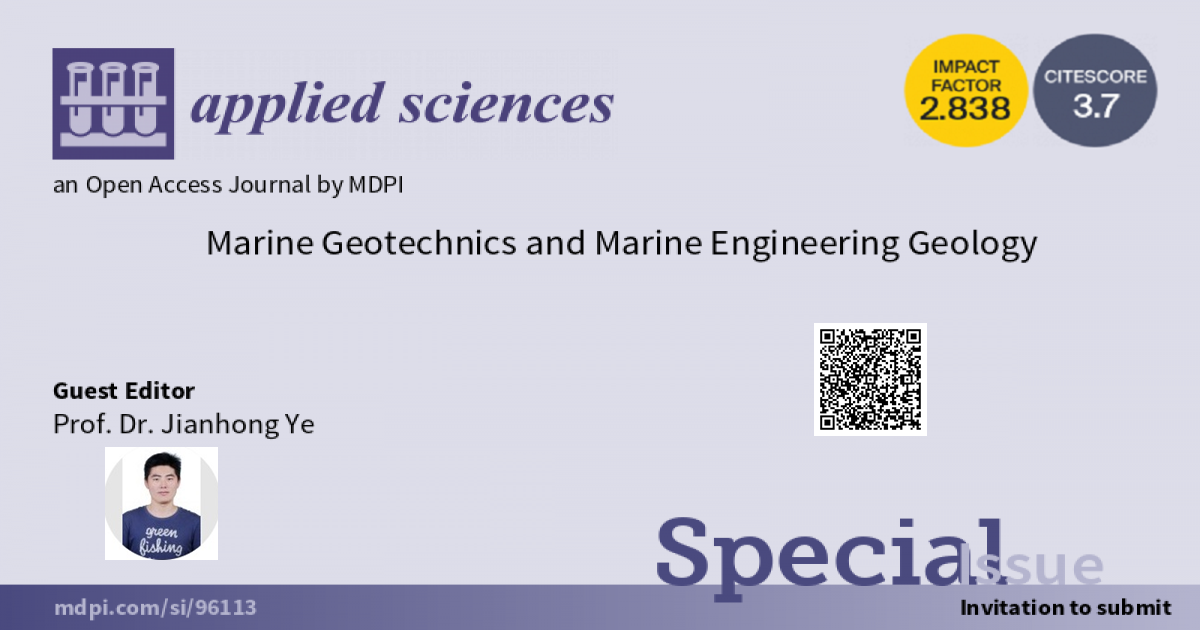- 2.5Impact Factor
- 5.5CiteScore
- 20 daysTime to First Decision
Marine Geotechnics and Marine Engineering Geology
This special issue belongs to the section “Marine Science and Engineering“.
Special Issue Information
Dear Colleagues,
Submissions exploring cutting-edge research and recent advances are invited to the Special Issue on Marine Geotechnics and Marine Engineering Geology.
In the past two decades, a great number of marine structures, e.g., breakwaters, offshore wind turbines, submarine pipeline, oil/gas platform cross-sea bridges, etc. have been constructed worldwide. Under the impact of environmental loads, such as ocean waves in typhoon climates and strong seismic waves, the stability of these marine structures is seriously threatened, especially when they are built on less dense seabed foundation. This Special Issue will focus on theoretical, experimental, and numerical studies related to the dynamic response, as well as the stability evaluation of all kinds of marine structures and their seabed foundation under environmental loads. Studies focusing on the experimental or mathematical description of the mechanical properties of conventional or gas hydrate marine soils and marine geological disasters threatening the stability of marine structures, as well as on the techniques/methods for the field monitoring of marine structures and seabed foundation, are also warmly welcome.
Prof. Dr. Jianhong Ye
Guest Editor
Manuscript Submission Information
Manuscripts should be submitted online at www.mdpi.com by registering and logging in to this website. Once you are registered, click here to go to the submission form. Manuscripts can be submitted until the deadline. All submissions that pass pre-check are peer-reviewed. Accepted papers will be published continuously in the journal (as soon as accepted) and will be listed together on the special issue website. Research articles, review articles as well as short communications are invited. For planned papers, a title and short abstract (about 250 words) can be sent to the Editorial Office for assessment.
Submitted manuscripts should not have been published previously, nor be under consideration for publication elsewhere (except conference proceedings papers). All manuscripts are thoroughly refereed through a single-blind peer-review process. A guide for authors and other relevant information for submission of manuscripts is available on the Instructions for Authors page. Applied Sciences is an international peer-reviewed open access semimonthly journal published by MDPI.
Please visit the Instructions for Authors page before submitting a manuscript. The Article Processing Charge (APC) for publication in this open access journal is 2400 CHF (Swiss Francs). Submitted papers should be well formatted and use good English. Authors may use MDPI's English editing service prior to publication or during author revisions.
Keywords
- marine geotechnics
- marine engineering geology
- marine structures
- fluid-structure-seabed interation
- seismic dynamics of offshore structures

Benefits of Publishing in a Special Issue
- Ease of navigation: Grouping papers by topic helps scholars navigate broad scope journals more efficiently.
- Greater discoverability: Special Issues support the reach and impact of scientific research. Articles in Special Issues are more discoverable and cited more frequently.
- Expansion of research network: Special Issues facilitate connections among authors, fostering scientific collaborations.
- External promotion: Articles in Special Issues are often promoted through the journal's social media, increasing their visibility.
- e-Book format: Special Issues with more than 10 articles can be published as dedicated e-books, ensuring wide and rapid dissemination.

